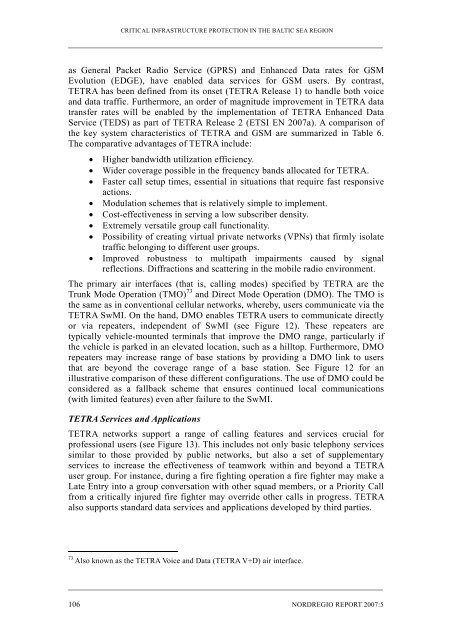Towards a Baltic Sea Region Strategy in Critical ... - Helsinki.fi
Towards a Baltic Sea Region Strategy in Critical ... - Helsinki.fi
Towards a Baltic Sea Region Strategy in Critical ... - Helsinki.fi
Create successful ePaper yourself
Turn your PDF publications into a flip-book with our unique Google optimized e-Paper software.
CRITICAL INFRASTRUCTURE PROTECTION IN THE BALTIC SEA REGION<br />
as General Packet Radio Service (GPRS) and Enhanced Data rates for GSM<br />
Evolution (EDGE), have enabled data services for GSM users. By contrast,<br />
TETRA has been def<strong>in</strong>ed from its onset (TETRA Release 1) to handle both voice<br />
and data traf<strong>fi</strong>c. Furthermore, an order of magnitude improvement <strong>in</strong> TETRA data<br />
transfer rates will be enabled by the implementation of TETRA Enhanced Data<br />
Service (TEDS) as part of TETRA Release 2 (ETSI EN 2007a). A comparison of<br />
the key system characteristics of TETRA and GSM are summarized <strong>in</strong> Table 6.<br />
The comparative advantages of TETRA <strong>in</strong>clude:<br />
• Higher bandwidth utilization ef<strong>fi</strong>ciency.<br />
• Wider coverage possible <strong>in</strong> the frequency bands allocated for TETRA.<br />
• Faster call setup times, essential <strong>in</strong> situations that require fast responsive<br />
actions.<br />
• Modulation schemes that is relatively simple to implement.<br />
• Cost-effectiveness <strong>in</strong> serv<strong>in</strong>g a low subscriber density.<br />
• Extremely versatile group call functionality.<br />
• Possibility of creat<strong>in</strong>g virtual private networks (VPNs) that <strong>fi</strong>rmly isolate<br />
traf<strong>fi</strong>c belong<strong>in</strong>g to different user groups.<br />
• Improved robustness to multipath impairments caused by signal<br />
reflections. Diffractions and scatter<strong>in</strong>g <strong>in</strong> the mobile radio environment.<br />
The primary air <strong>in</strong>terfaces (that is, call<strong>in</strong>g modes) speci<strong>fi</strong>ed by TETRA are the<br />
Trunk Mode Operation (TMO) 73 and Direct Mode Operation (DMO). The TMO is<br />
the same as <strong>in</strong> conventional cellular networks, whereby, users communicate via the<br />
TETRA SwMI. On the hand, DMO enables TETRA users to communicate directly<br />
or via repeaters, <strong>in</strong>dependent of SwMI (see Figure 12). These repeaters are<br />
typically vehicle-mounted term<strong>in</strong>als that improve the DMO range, particularly if<br />
the vehicle is parked <strong>in</strong> an elevated location, such as a hilltop. Furthermore, DMO<br />
repeaters may <strong>in</strong>crease range of base stations by provid<strong>in</strong>g a DMO l<strong>in</strong>k to users<br />
that are beyond the coverage range of a base station. See Figure 12 for an<br />
illustrative comparison of these different con<strong>fi</strong>gurations. The use of DMO could be<br />
considered as a fallback scheme that ensures cont<strong>in</strong>ued local communications<br />
(with limited features) even after failure to the SwMI.<br />
TETRA Services and Applications<br />
TETRA networks support a range of call<strong>in</strong>g features and services crucial for<br />
professional users (see Figure 13). This <strong>in</strong>cludes not only basic telephony services<br />
similar to those provided by public networks, but also a set of supplementary<br />
services to <strong>in</strong>crease the effectiveness of teamwork with<strong>in</strong> and beyond a TETRA<br />
user group. For <strong>in</strong>stance, dur<strong>in</strong>g a <strong>fi</strong>re <strong>fi</strong>ght<strong>in</strong>g operation a <strong>fi</strong>re <strong>fi</strong>ghter may make a<br />
Late Entry <strong>in</strong>to a group conversation with other squad members, or a Priority Call<br />
from a critically <strong>in</strong>jured <strong>fi</strong>re <strong>fi</strong>ghter may override other calls <strong>in</strong> progress. TETRA<br />
also supports standard data services and applications developed by third parties.<br />
73 Also known as the TETRA Voice and Data (TETRA V+D) air <strong>in</strong>terface.<br />
106 NORDREGIO REPORT 2007:5

















